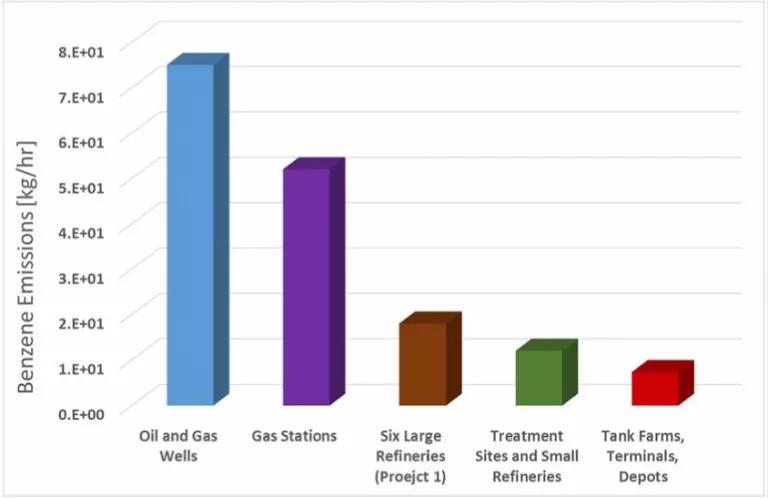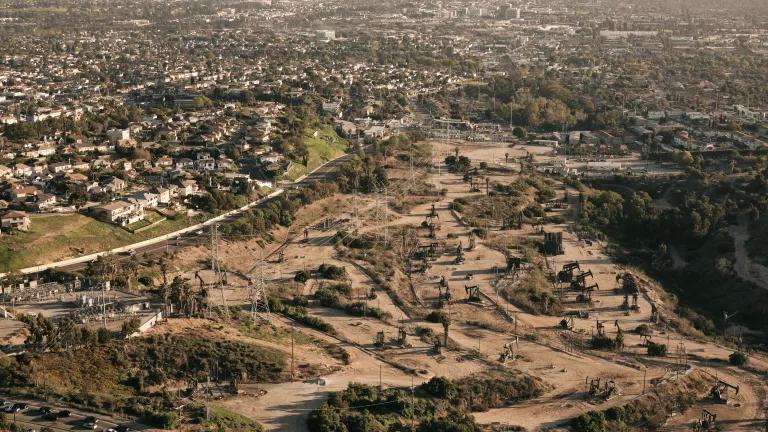AB 345: Please Keep Off the Astroturf
AB 345, which passed the California Assembly and is now pending in the Senate, would require regulators to establish setback buffers to keep drilling operations away from homes, schools, playgrounds, and hospitals.

If you are one of those 5.4 million Californians living within a mile of oil and gas drilling operations, studies show that smell in the air may well be air pollution that risks harm to your health. But you may be catching a whiff of something else too: desperation from the oil and gas industry, which sees that efforts to establish setback buffers are finally being considered seriously by the California legislature. You may experience dizziness if you’re too close either to air toxics from oil wells, or to industry’s frantic falsehood-laced spinning aimed at keeping those wells in your neighborhood.
So grab hold of your chair arms and check this out: a piece from “ExtractingFact” aiming to definitely take down AB 345, the bill that passed the California Assembly and is now pending in the Senate that would require regulators to establish setback buffers to keep drilling operations away from homes, schools, playgrounds, and hospitals.
What exactly is “ExtractingFact,” you may ask? Great question. The website states only that it is “A publication of Californians for Energy Independence.” Sounds like a grassroots group of concerned citizens, right? You’d certainly think so from the group’s website, which features nicely curated testimonies from a small handful of industry workers. Well, the other petrochemical smell in the air may be from the plastic in the Astroturf: this fake grassroots organization is funded and coordinated by some of the biggest oil industry lobbying organizations in the state as part of a campaign to derail California’s climate initiatives. An NRDC report from a few years ago documented how groups like the Western States Petroleum Association (WSPA), which spends millions of dollars annually lobbying in Sacramento, convened groups like this one to make it look like their messages were coming from somewhere other than oil companies. And if you doubt us, believe WSPA: a leaked PowerPoint presentation by its president a few years ago included this handy graphic showing all the campaigns and coalitions WSPA has “activated”:

The ExtractingFact piece is captioned “Assembly Bill 345 Arguments Based on Falsehoods,” and features a giant Pinocchio nose graphic. That’s cute. And deeply irony-challenged, and reflective of that well-known psychological phenomenon called projection.
The main item of “evidence” cited in the piece is a few lines lifted from a study by the City of Los Angeles Office of Petroleum and Natural Gas Administration and Safety (OPNGAS). The piece doesn’t actually provide a link to the study, and I wouldn’t either if I were them—because ExtractingFact shamelessly misrepresents its results through selective out-of-context quotation.
The OPNGAS report is 164 pages long, fairly exhaustively discussing multiple California studies relevant to human health and oil and gas development, and making recommendations based on them (including, as noted below, a recommendation concerning setbacks). In support of its conclusion that support for AB 345 is based on a “bogus, disproven narrative,” and that “any review of the scientific record would disprove” arguments in favor of it, ExtractingFact pulls out a few lines from page 145, which explain that these studies’ conclusions shouldn’t “lead to any public panic.”
Well, here’s the thing. We concur with OPNGAS that public panic is probably not the best approach—we’re inclined to reserve panic for alien invasions or sightings of the Stay-Puft Marshmallow man. However, the referenced studies specifically recommended a rational and decidedly non-panicked policy solution to address the very real health risk they identified: that’s right, setbacks. The studies by the LA County Department of Public Health and its Oil & Gas Strike Team both call for expanded setback buffers from oil and gas operations as a means of reducing the identified risk. And the OPNGAS report itself recommends that the LA City Planning department report on the feasibility of 600 and 1,500 foot setbacks from existing and new drilling, respectively.
It is thus more than a bit mendacious for ExtractingFact to conclude that “the studies reviewed by the [OPNGAS] Administrator found that ending oil and gas production would have no appreciable effect on public health.” Leaving aside the fact that the reviewed studies were not even addressing the idea of “ending oil and gas production”—if these studies don’t support a connection between drilling and risks to public health, then why, exactly, do our astroturfy friends think those studies recommended setbacks? For their own amusement?
ExtractingFact’s few quoted lines from the OPNGAS report also note that the evaluated studies did not provide evidence of “widespread negative health impacts” in the City of Los Angeles as a result of oil and gas operations. This is an unremarkable disclaimer, since the referenced studies were for the most part aimed at evaluating risk of public health harm rather than measuring health impacts at that specific location. But on the subject of risk, the OPNGAS study on the very next page quotes from a report by Physicians, Scientists, and Engineers for Healthy Energy (PSE), hired by the City of LA as a consultant to look at the larger body of literature on the subject:
The City's PSE consultants stated, "the science is relatively clear that the development of oil and gas immediately adjacent to places where people live, work and play poses hazards and risks to public health and that some minimum distance from sensitive receptors should be considered.” As such, they advised that a setback greater than 500 feet and up to 5,290 feet should be considered.
The fact of the matter is, there are dozens of studies published in recent years showing an association between proximity to oil and gas drilling operations and increased health risk – including, among other things, risk of poor pregnancy outcomes (birth defects, preterm birth, and fetal death), cancer, respiratory and cardiovascular problems, asthma exacerbation, and health problems associated with constant loud noise. You can read about it in my recent blog on the subject, and in NRDC and Environmental Working Group’s comments concerning setbacks submitted earlier this month to the Division of Geologic Energy Management (CalGEM).
The comments also discuss the PSE report’s conclusion that this body of scientific literature is relevant to California, and cite two June 2020 California health risk studies whose conclusions are in line with the national scientific consensus: one finding that pregnant women living within one kilometer of the highest producing wells were 40 percent more likely to have babies with low birthweights; and another identifying an association between proximity to oil and gas wells and spontaneous preterm birth.
ExtractingFact further relies on a time-honored tactic of statistical distortion: diluting the significance of a very large number by comparing it to a number that is both ginormous and irrelevant. It states reassuringly that production operations “contributed just 2% of emissions reported by the California Air Resources Control Board.” Leaving aside the fact that 2% of all reported emissions is not exactly a trivial number, it’s entirely beside the point. The issue when considering setbacks is not how much oil and gas operations contribute to total air pollution overall, but whether their pollution is particularly harmful, and concentrated near those operations. The answers to those more relevant questions are yes and yes. Research has shown that levels of carcinogenic air toxics are higher near oil and gas operations; and the OPNGAS report included data showing that South Coast Air Basin oil and gas wells are a disproportionately high source of such emissions as compared with other stationary sources, summarized in this chart from its report concerning benzene, for example:

It’s pretty clear, it seems, who’s the true owner of ExtractingFact’s Pinocchio nose, and it’s not the scientists, policymakers, and advocates working diligently to address the very real health risk associated with oil and gas wells—which disproportionately affects communities of color. Californians who are concerned about public health and environmental justice should join the effort to address those risks through setbacks by using this link to ask their senator to support AB 345. And stay away from Astroturf and dizzying industry spin.




